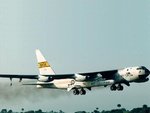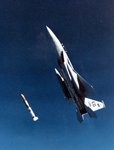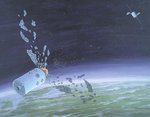ccheese
Member In Perpetuity
WASHINGTON — The Pentagon, under orders from President Bush, is planning to shoot down a broken spy satellite expected to hit the Earth in early March, the White House said Thursday.
U.S. officials said that the option preferred by the administration will be to fire a missile from a U.S. Navy cruiser, and shoot down the satellite before it enters Earth's atmosphere.
White House press secretary Dana Perino said that Bush made his decision during the past week and asked experts to come up with a way to destoy the satellite.
He made the decision to shoot it down because the satellite was carrying the rocket fuel hydrazine, Perino said.
Initally the administration believed that the danger from the falling satellite did not pose a large problem, but decided it was best to shoot it down when experts decided that the unused hydrazine did pose a danger.
Asked about the matter, Pentagon spokesman Bryan Whitman said, "We have been looking at ways to mitigate the possible risk to human lives and to demonstrate our continuing commitment to safe and responsible space operations."
The disabled satellite is expected to hit the Earth the first week of March. Officials said the Navy would likely shoot it down before then, using a special missile modified for the task.
Other details about the missile and the targeting were not immediately available. But the decision involves several U.S. agencies, including the Department of Homeland Security and the State Department.
One of the main goals of the satellite's destruction is to prevent any sensitive equipment from falling into the wrong hands.
"We are worried about something showing up on e-Bay," defense and intelligence expert John Pike said, adding that breaking up the satellite's pieces lessens the chance that sensitive U.S. technology could wind up in Chinese hands.
"What they have to be worried about is that a souvenir collector is going to find some piece, put it on e-Bay and the Chinese buy it," said Pike, who is director of the defense research group GlobalSecurity.org.
"The Chinese and the Russians spend an enormous amount of time trying to steal American technology," Pike said last week. "To have our most sophisticated radar intelligence satellite — have big pieces of it fall into their hands — would not be our preferred outcome."
The State Department declined to comment on the plan ahead of the Pentagon announcement, but said its role in such a scenario would be to inform foreign governments that the action was not hostile in nature.
"You want to make sure that everybody understands exactly what actions are being taken so there are no misunderstandings and misperceptions and also to reassure people vis-a-vis treaty obligations," spokesman Sean McCormack told reporters.
Shooting down a satellite is particularly sensitive because of the controversy surrounding China's anti-satellite test last year, when Beijing shot down one of its defunct weather satellites, drawing immediate criticism from the U.S. and other countries.
A key concern at that time was the debris created by Chinese satellite's destruction — and that will also be a focus now, as the U.S. determines exactly when and under what circumstances to shoot down its errant satellite.
The military will have to choose a time and a location that will avoid to the greatest degree any damage to other satellites in the sky.
Also, there is the possibility that large pieces could remain, and either stay in orbit where they can collide with other satellites or possibly fall to Earth.
It is not known where the satellite will hit. But officials familiar with the situation say about half of the 5,000-pound spacecraft is expected to survive its blazing descent through the atmosphere and will scatter debris — some of it potentially hazardous — over several hundred miles.
The officials spoke on condition of anonymity because of the sensitivity of the matter.
Short-term exposure to hydrazine could cause coughing, irritated throat and lungs, convulsions, tremors or seizures, according to the Centers for Disease Control and Prevention.
Long-term exposure could damage the liver, kidney and reproductive organs.
Where the satellite would land would be difficult to predict until it descends to about 59 miles above the Earth and enters the atmosphere.
It would then begin to burn up, with flares visible from the ground, said Ted Molczan, a Canadian satellite tracker. From that point on, he said, it would take about 30 minutes to fall.
The satellite is outfitted with thrusters — small engines used to position it in space. They contain the toxic rocket fuel hydrazine, which can cause harm to anyone who contacts it. Officials have said there are about 1,000 pounds of propellant on the satellite.
Known by its military designation US 193, the satellite was launched in December 2006. It lost power and its central computer failed almost immediately afterward, leaving it uncontrollable. It carried a sophisticated and secret imaging sensor.
The military's Ballistic Missile Defense System, known as "Sea-Based Midcourse," could destroy the satellite just as it begins to re-enter the Earth's atmosphere, said James Lewis, a satellite expert at the Washington-based Center for Strategic and International Studies, a conservative think-tank.
That would undercut any international criticism of a "war in space," Lewis said, and reframe it as a ballistic missile defense exercise.
He said it could also avoid the problem of creating a large debris field of satellite pieces that would continue to orbit.
The goal, said Lewis, would be to explode the satellite into small pieces that would mostly burn up as they re-enter the atmosphere.
In the past 50 years, about 17,000 man-made objects have re-entered the Earth's atmosphere.
The largest uncontrolled re-entry by a NASA spacecraft was Skylab, the 78-ton abandoned space station that fell from orbit in 1979. Its debris dropped harmlessly into the Indian Ocean and across a remote section of western Australia.
In 2000, NASA engineers successfully directed a safe de-orbit of the 17-ton Compton Gamma Ray Observatory, using rockets aboard the satellite to bring it down in a remote part of the Pacific Ocean.
In 2002, officials believe debris from a 7,000-pound science satellite smacked into the Earth's atmosphere and rained down over the Persian Gulf, a few thousand miles from where they first predicted it would plummet.
This from Fox News... (and CNN)
Charles
U.S. officials said that the option preferred by the administration will be to fire a missile from a U.S. Navy cruiser, and shoot down the satellite before it enters Earth's atmosphere.
White House press secretary Dana Perino said that Bush made his decision during the past week and asked experts to come up with a way to destoy the satellite.
He made the decision to shoot it down because the satellite was carrying the rocket fuel hydrazine, Perino said.
Initally the administration believed that the danger from the falling satellite did not pose a large problem, but decided it was best to shoot it down when experts decided that the unused hydrazine did pose a danger.
Asked about the matter, Pentagon spokesman Bryan Whitman said, "We have been looking at ways to mitigate the possible risk to human lives and to demonstrate our continuing commitment to safe and responsible space operations."
The disabled satellite is expected to hit the Earth the first week of March. Officials said the Navy would likely shoot it down before then, using a special missile modified for the task.
Other details about the missile and the targeting were not immediately available. But the decision involves several U.S. agencies, including the Department of Homeland Security and the State Department.
One of the main goals of the satellite's destruction is to prevent any sensitive equipment from falling into the wrong hands.
"We are worried about something showing up on e-Bay," defense and intelligence expert John Pike said, adding that breaking up the satellite's pieces lessens the chance that sensitive U.S. technology could wind up in Chinese hands.
"What they have to be worried about is that a souvenir collector is going to find some piece, put it on e-Bay and the Chinese buy it," said Pike, who is director of the defense research group GlobalSecurity.org.
"The Chinese and the Russians spend an enormous amount of time trying to steal American technology," Pike said last week. "To have our most sophisticated radar intelligence satellite — have big pieces of it fall into their hands — would not be our preferred outcome."
The State Department declined to comment on the plan ahead of the Pentagon announcement, but said its role in such a scenario would be to inform foreign governments that the action was not hostile in nature.
"You want to make sure that everybody understands exactly what actions are being taken so there are no misunderstandings and misperceptions and also to reassure people vis-a-vis treaty obligations," spokesman Sean McCormack told reporters.
Shooting down a satellite is particularly sensitive because of the controversy surrounding China's anti-satellite test last year, when Beijing shot down one of its defunct weather satellites, drawing immediate criticism from the U.S. and other countries.
A key concern at that time was the debris created by Chinese satellite's destruction — and that will also be a focus now, as the U.S. determines exactly when and under what circumstances to shoot down its errant satellite.
The military will have to choose a time and a location that will avoid to the greatest degree any damage to other satellites in the sky.
Also, there is the possibility that large pieces could remain, and either stay in orbit where they can collide with other satellites or possibly fall to Earth.
It is not known where the satellite will hit. But officials familiar with the situation say about half of the 5,000-pound spacecraft is expected to survive its blazing descent through the atmosphere and will scatter debris — some of it potentially hazardous — over several hundred miles.
The officials spoke on condition of anonymity because of the sensitivity of the matter.
Short-term exposure to hydrazine could cause coughing, irritated throat and lungs, convulsions, tremors or seizures, according to the Centers for Disease Control and Prevention.
Long-term exposure could damage the liver, kidney and reproductive organs.
Where the satellite would land would be difficult to predict until it descends to about 59 miles above the Earth and enters the atmosphere.
It would then begin to burn up, with flares visible from the ground, said Ted Molczan, a Canadian satellite tracker. From that point on, he said, it would take about 30 minutes to fall.
The satellite is outfitted with thrusters — small engines used to position it in space. They contain the toxic rocket fuel hydrazine, which can cause harm to anyone who contacts it. Officials have said there are about 1,000 pounds of propellant on the satellite.
Known by its military designation US 193, the satellite was launched in December 2006. It lost power and its central computer failed almost immediately afterward, leaving it uncontrollable. It carried a sophisticated and secret imaging sensor.
The military's Ballistic Missile Defense System, known as "Sea-Based Midcourse," could destroy the satellite just as it begins to re-enter the Earth's atmosphere, said James Lewis, a satellite expert at the Washington-based Center for Strategic and International Studies, a conservative think-tank.
That would undercut any international criticism of a "war in space," Lewis said, and reframe it as a ballistic missile defense exercise.
He said it could also avoid the problem of creating a large debris field of satellite pieces that would continue to orbit.
The goal, said Lewis, would be to explode the satellite into small pieces that would mostly burn up as they re-enter the atmosphere.
In the past 50 years, about 17,000 man-made objects have re-entered the Earth's atmosphere.
The largest uncontrolled re-entry by a NASA spacecraft was Skylab, the 78-ton abandoned space station that fell from orbit in 1979. Its debris dropped harmlessly into the Indian Ocean and across a remote section of western Australia.
In 2000, NASA engineers successfully directed a safe de-orbit of the 17-ton Compton Gamma Ray Observatory, using rockets aboard the satellite to bring it down in a remote part of the Pacific Ocean.
In 2002, officials believe debris from a 7,000-pound science satellite smacked into the Earth's atmosphere and rained down over the Persian Gulf, a few thousand miles from where they first predicted it would plummet.
This from Fox News... (and CNN)
Charles





